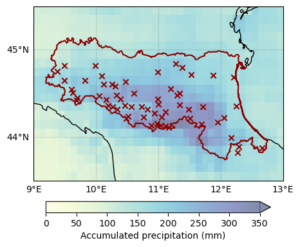The three rainfall events were driven by three distinct low-pressure systems situated over the Tyrrhenian Sea. The first of the three heavy rainfall events occurred after two years of drought in Northern Italy due to below-average winter snowfall in the Alps, Dolomites, and Apennines. For the two subsequent events the soils were, however, saturated. The accumulated precipitation of the three spells of heavy rainfall resulted in 23 river banks being flooded in the region, submerging settlements and leaving thousands homeless. The heavy rainfall also caused over 400 landslides, of which several were severe.
To analyse whether and to what extent human-caused climate change altered the likelihood and intensity of this extreme rainfall, scientists from Italy, the Netherlands, France, the US, and the UK used published, peer-reviewed methods to perform an event attribution study. Given that the deluge and the impacts over the Emilia-Romagna region (red outline in fig. 1) were a consequence of a series of short but heavy rainfall spells occurring within a span of three weeks, the team looked at an event defined as the maximum accumulated 21-day rainfall (Rx21d) in April-June (AMJ), averaged over the region.

Main Findings
- While the full profile of the impacts on human life and livelihoods has yet to be analysed, initial assessments show that the floods and landslides caused 17 fatalities and displaced roughly 50.000 people. The majority of the deceased were elderly and died in their homes, in many cases linked to either reduced mobility or reluctance to evacuate. These deaths highlight how pre-existing vulnerabilities such as disability and limited risk perception exacerbated the impacts in the region.
- For observational analysis, we looked at spring rainfall in the study region based on a dense network of about 60 weather stations in the area that have consistent data since at least the 1960s. The heavy rainfall over the first 21 days of May 2023 is the wettest event of this type in the record with a return time estimated to be about 200 years. This means that in any given year, the chance of such an event occurring is about 0.5%.
- In the station data as well as other observational data products there is no significant trend in the 21-day spring rainfall: thus the amount of rain that falls in a 200-year event today is the same as in a 200-year event at the beginning of the record.
- To determine whether there is indeed no trend due to human-induced climate change or whether a trend is masked by changes in other drivers of rainfall, such as land-use changes or changes in aerosols, we look at the same 21-day event in climate models with and without the human-induced increase in climate change. Of the 19 models used, none of them show a significant change in the likelihood or intensity of such an event to occur. This suggests that in contrast to most parts of the world, there is indeed no detectable increase in heavy rainfall in the Emilia-Romagna region in spring.
- This finding corroborates earlier research that has found that with human-induced climate change the number of low-pressure systems in the central Mediterranean has decreased. This leads to a reduction in heavy rainfall, offsetting the expected increase in heavy rain from global warming.
- In recent decades, rapid urbanisation and increasingly dense urban fabric has limited space for water drainage and increased risk of flooding, which has exacerbated the impacts of the heavy rainfall. However, this was an extremely rare event, and most infrastructure cannot reasonably be built to withstand such low-frequency events.
- There are many adaptation options that are robust to multiple types of extremes (e.g. drought, heat, floods) and also have co-benefits for societal well-being and biodiversity, which can increase the resilience of this region to future extremes. Nature-based solutions, social protection, and improved urban planning, are just a few examples.





